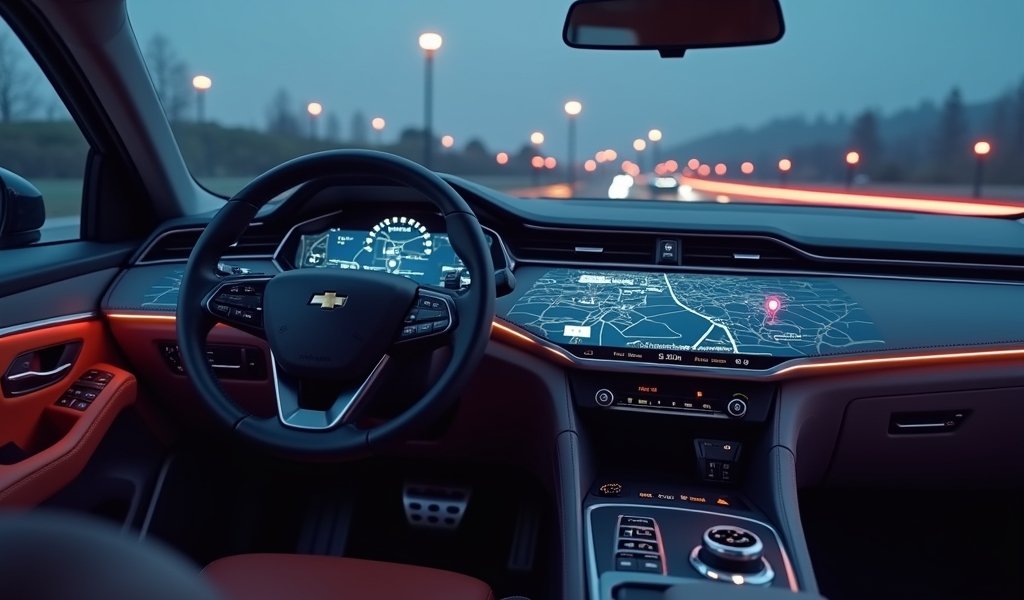Overview
This article reviews the five best Apple CarPlay navigation apps, comparing Google Maps, Apple Maps, Waze, TomTom GO, and Sygic GPS across criteria like offline capabilities, traffic data, interface clarity, and standout features. Each app offers distinct advantages for different driving needs, with Google Maps standing as the reliable all-rounder, Apple Maps excelling in iOS integration, Waze providing real-time hazard reporting, TomTom featuring superior offline navigation, and Sygic delivering impressive 3D visuals.
Table of Contents
- Introduction to CarPlay Navigation Apps
- Google Maps: The Reliable Navigator
- Apple Maps: The Seamlessly Integrated Option
- Waze: The Community-Powered Navigator
- TomTom GO Navigation: The Veteran Pathfinder
- Sygic GPS Navigation: Feature-Rich Alternative
- Head-to-Head Comparison
- Conclusion: Choosing Your Digital Co-Pilot
- Frequently Asked Questions
Introduction to CarPlay Navigation Apps
Remember the days of unfolding oversized paper maps in your passenger seat or printing MapQuest directions before a trip? Those days are long behind us. Now, Apple CarPlay navigation apps transform your vehicle’s dashboard into a smart guidance system that keeps you on track while letting you focus on the road.
As a mechanic who’s seen countless drivers struggle with directions, I can tell you that the best carplay navigation apps do more than just get you from point A to point B—they reduce stress, save time, and even help prevent unnecessary wear on your vehicle from needless detours or idling in traffic.
Whether you’re navigating city streets during rush hour or exploring back roads on a weekend getaway, having reliable navigation is as essential as having a well-maintained engine. Let’s pop the hood on the five best navigation apps for Apple CarPlay, examining what makes each one unique and which might be the perfect fit for your driving needs.
Google Maps: The Reliable Navigator

Google Maps stands as the trusted mechanic of the navigation world—it’s been around the block, knows all the shortcuts, and rarely steers you wrong. When it comes to best carplay navigation apps, Google Maps often tops the list for good reason.
Standout Features
Google Maps on CarPlay delivers a clean, uncluttered interface that presents just what you need without overwhelming you with information. The voice guidance is clear and timely, providing instructions that even new drivers can follow with confidence.
What impresses me most as someone who’s spent decades on the road is the lane guidance system. Just like I’d tell you exactly which lane to be in when approaching a complex interchange, Google Maps highlights your optimal lane position well in advance, preventing those last-minute, stress-inducing lane changes that wear on both you and your brakes.
The offline capabilities are particularly handy for those long stretches of highway where cell service disappears faster than engine coolant on a hot day. Before heading out, you can download entire regions to your phone, ensuring continuous navigation regardless of signal strength.
Real-World Performance
Google’s traffic predictions are like having a trusted spotter watching the road ahead. Drawing from millions of data points, it accurately forecasts congestion and suggests alternate routes that can save you time and fuel. According to recent research on traffic prediction algorithms, Google’s approach consistently ranks among the most reliable.
The points of interest database is comprehensive, making it easy to find everything from the nearest garage to a specific restaurant. This valuable feature for road trips means you’re never far from fuel, food, or facilities when needed.
Battery consumption is something to watch, though. Like an older car that drinks a bit more fuel, Google Maps can be thirstier for battery power than some alternatives. Keep your phone plugged in during longer journeys to avoid running on empty.
Apple Maps: The Seamlessly Integrated Option
If Google Maps is the trusted independent garage, Apple Maps is the factory-certified service center for your iPhone. As the default navigation app for CarPlay, it starts with a home-field advantage that’s hard to ignore.
Native Integration Benefits
Apple Maps launches instantly on CarPlay with zero configuration needed. This seamless integration extends throughout the experience, from how quickly it responds to how naturally it works with other CarPlay functions.
The Siri integration feels like having a knowledgeable co-driver who knows exactly what you need. Simple voice commands like “Hey Siri, find the closest gas station with good prices” trigger immediate, helpful responses. This hands-free operation is more than convenient—it’s a safety feature that keeps your hands on the wheel where they belong.
Recent Improvements
Apple Maps has undergone a complete overhaul in recent years, much like a restoration of a classic car. The company has rebuilt its mapping data from the ground up, resulting in more detailed road networks, improved pedestrian guidance, and enhanced landmark recognition.
The “Look Around” feature offers street-level previews with smoother transitions than competitors. For complex interchanges, Apple Maps excels with its exceptional junction view that clearly illustrates which lane you should occupy—similar to having a mechanic draw you a diagram before tackling a tricky repair.
While Apple Maps once lagged behind in accuracy, it now rivals Google Maps in most urban areas. However, in rural regions, you might still find less detailed points of interest—like trying to find a specialized part shop in a small town. The offline capabilities, while improved, aren’t quite as robust as some competitors, so keep that in mind when venturing off the beaten path.
Waze: The Community-Powered Navigator
Waze is the navigation equivalent of a CB radio network from the trucking world—it harnesses the collective knowledge of drivers to create a real-time picture of road conditions that static maps simply can’t match.
Community-Driven Intelligence
What sets Waze apart in the best carplay navigation apps lineup is its crowdsourced approach. Users actively report accidents, police presence, road hazards, and even gas prices as they drive. This creates a constantly updated map that reflects actual conditions with impressive accuracy.
For daily commuters, this community intelligence is like having scouts checking the road ahead. The app will alert you to everything from a stalled vehicle around the next bend to debris in the lane—often before official traffic reports catch wind of the situation. This real-time traffic information can save you from unexpected delays that waste time and fuel.
Unique Route Finding
Waze approaches route finding like a local mechanic who knows all the backstreet shortcuts. It’s not afraid to route you through residential areas and side streets if that’s the fastest way around congestion. This can be a double-edged sword—sometimes these creative routes are genuine time-savers, while other times they might send you through complex neighborhoods unnecessarily.
The interface is more playful than its competitors, with colorful icons and even customizable vehicle avatars. Despite this personality, the important information remains clear and accessible at a glance, much like a well-designed dashboard that puts critical gauges right where you need them.
Keep in mind that Waze tends to be more battery-intensive and data-hungry than other navigation options. Like a high-performance vehicle that demands premium fuel, Waze works best when your phone is plugged in and you have a generous data plan.
TomTom GO Navigation: The Veteran Pathfinder
TomTom is to navigation what a seasoned master mechanic is to car repair—backed by decades of experience and specialized knowledge. Long before smartphones existed, TomTom was guiding drivers with dedicated GPS devices, and that expertise shines through in their CarPlay offering.
Offline Excellence
Where TomTom truly excels is in its comprehensive offline navigation capabilities. Just as I’d recommend carrying essential tools for remote journeys, I suggest TomTom for drivers who frequently venture beyond cellular coverage. Its offline maps include not just road networks but detailed points of interest, making it invaluable for rural and wilderness travelers.
The maps themselves offer exceptional clarity and detail. Road elements are distinctly rendered with sharp contrast, making them readable even in bright sunlight—just like a well-designed gauge cluster that remains visible in all lighting conditions.
Premium Features Worth Noting
TomTom operates on a subscription model after an initial free trial, but the premium features justify the cost for many drivers. The advanced lane guidance shows remarkably detailed 3D junction views that eliminate guesswork at complex interchanges. Their speed camera warnings (where legal) are consistently accurate and potentially ticket-saving.
Perhaps most impressive is TomTom’s traffic prediction technology. Rather than simply reporting current conditions, it analyzes historical patterns to predict how traffic will evolve during your journey. This predictive approach helps you avoid congestion before it forms—like changing your oil before problems develop, rather than after.
The main drawbacks are the subscription cost and a search function that occasionally feels less intuitive than Google’s or Apple’s offerings. Map updates, while comprehensive, sometimes arrive slightly later than competitors—similar to waiting for specialized parts rather than off-the-shelf components.
Sygic GPS Navigation: Feature-Rich Alternative

Rounding out our exploration of best carplay navigation apps is Sygic—the specialized performance shop of navigation. While not as widely known as the big names, Sygic packs premium features that make it worth consideration for discerning drivers.
Visual Excellence and Specialized Tools
Sygic’s 3D mapping is among the most visually impressive available. The realistic representation of buildings and landmarks helps drivers correlate the digital map with their real-world surroundings—particularly valuable when navigating unfamiliar urban environments.
The lane guidance system deserves special mention for its clarity and detail. Complex highway interchanges are rendered with precision that eliminates confusion, showing exactly which lane leads where. This is like having detailed schematics rather than basic diagrams when working on a complex repair job.
For travelers, Sygic integrates tourist information directly into the navigation experience. The app highlights attractions, recommended restaurants, and points of interest that might not appear in other navigation apps—like having a local’s knowledge of the area built right in.
Subscription Considerations
Sygic operates on a freemium model, offering basic functionality for free but reserving its most valuable features for subscribers. Lifetime licenses are available for those who prefer a one-time purchase over recurring payments—similar to buying rather than leasing a vehicle.
The interface can sometimes feel busy with information, and the search functionality occasionally proves less intuitive than Google’s. Updates, while comprehensive, sometimes arrive a bit later than the industry leaders. These minor issues aside, Sygic remains an excellent choice for drivers who value visual detail and specialized navigation features.
Head-to-Head Comparison
When choosing among the best carplay navigation apps, it’s helpful to see how they stack up side by side—much like comparing vehicles before making a purchase. Here’s how our contenders compare across key categories:
| App | Price | Offline Maps | Traffic Data | UI Clarity | Standout Feature |
|---|---|---|---|---|---|
| Google Maps | Free | Very Good | Excellent | High | Comprehensive POI database |
| Apple Maps | Free | Good | Very Good | Excellent | Seamless iOS integration |
| Waze | Free | Limited | Excellent | Good | Real-time hazard reporting |
| TomTom GO | Subscription | Excellent | Very Good | Good | Traffic prediction |
| Sygic | Freemium | Excellent | Good | Very Good | 3D landmarks |
Each app has clear strengths that might make it ideal depending on your specific needs. Just as I might recommend different vehicles based on whether you’re commuting, hauling, or off-roading, the best navigation app depends on your typical driving scenarios.
Conclusion: Choosing Your Digital Co-Pilot
After thoroughly road-testing the best carplay navigation apps available today, it’s clear that each offers unique advantages for different driving scenarios. Like choosing the right tool for a repair job, selecting the ideal navigation app depends on your specific needs and circumstances.
For most drivers, Google Maps remains the gold standard with its combination of accuracy, real-time traffic data, and comprehensive point of interest database. It’s the reliable all-rounder that rarely disappoints.
Apple Maps deserves serious consideration, especially for iPhone devotees. Its seamless integration with iOS and Siri makes for a frictionless experience, and its recent improvements have closed the gap with Google considerably.
For daily commuters battling traffic, Waze’s community-powered approach to real-time hazards and congestion makes it an invaluable ally. Meanwhile, road-trippers venturing beyond cellular coverage will appreciate TomTom’s excellent offline capabilities, and those who value visual guidance will find Sygic’s detailed 3D maps impressive.
Many experienced drivers, myself included, find value in keeping two navigation apps installed. This redundancy provides a backup when one app struggles with a particular route or when cellular service becomes unreliable—just like having both a spare tire and roadside assistance for different types of breakdowns.
Whichever digital co-pilot you choose for your journeys, the days of getting hopelessly lost or stuck in avoidable traffic are, thankfully, behind us. Modern navigation apps have transformed driving in ways that would have seemed magical just a generation ago.
Happy travels and smooth navigation wherever your journeys take you!
Frequently Asked Questions
Do I need an internet connection to use CarPlay navigation apps?
Most CarPlay navigation apps require an internet connection for full functionality including live traffic and route calculations. Google Maps, TomTom, and Sygic offer robust offline map downloads for navigation without cellular data.
Can I use multiple navigation apps on CarPlay simultaneously?
No, CarPlay only allows one navigation app to run at a time. You can quickly switch between apps, but you cannot view two navigation interfaces simultaneously.
Do all cars with infotainment systems support CarPlay?
No, CarPlay requires specific hardware support from the vehicle manufacturer. Most newer vehicles (2016 and later) offer CarPlay, but you should check your car’s specifications to confirm compatibility.
Which navigation app uses the least data?
Apple Maps typically uses less data than Google Maps or Waze for similar journeys. For minimal data usage, apps with offline capabilities like TomTom or Sygic with pre-downloaded maps use virtually no data during navigation.
Can I customize the route to avoid tolls or highways?
Yes, all five navigation apps discussed allow you to customize routes to avoid tolls, highways, ferries, or other road types. These settings are typically found in the route options before starting navigation.

